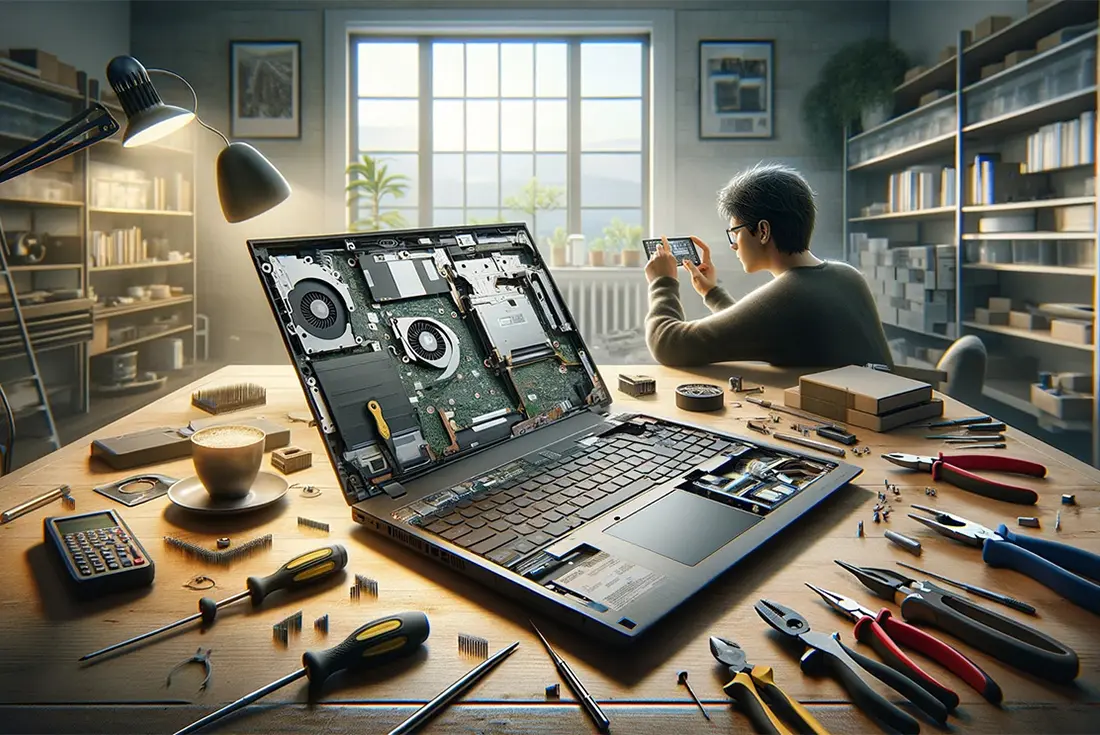
01 Jul Reviving Your PC: 10 Expert Tips on Computer Repair
We’ve all been there – that sinking feeling when your computer freezes, crashes, or the dreaded blue screen of death appears. Or maybe it’s the gut-wrenching moment you realize your laptop screen is cracked after an accidental drop. These moments can induce panic and frustration, especially when you rely on your PC for work, school, or entertainment. But fear not! With a little knowledge and guidance, you can often troubleshoot and even repair many common computer issues yourself.
This guide will provide you with 10 expert tips on computer repair, from diagnosing simple problems to tackling more complex issues like broken laptop screen repair. We’ll also discuss when it’s time to call in the professionals for IT support. Empower yourself with the knowledge to revive your PC and get back to productivity!
Tip 1: Diagnose Before You Act
The first step in any computer repair is to accurately diagnose the problem. Is the issue hardware-related, like a broken laptop screen or a faulty keyboard? Or is it a software problem, such as a virus infection or a corrupted file? Identifying the root cause will help you determine the best course of action.
Start by checking for obvious signs of damage, such as loose cables or broken parts. Then, try some basic troubleshooting steps like restarting your computer, checking for software updates, and running antivirus scans. If the problem persists, it may be time to move on to more specific repairs.
Tip 2: Dealing with a Broken or Malfunctioning Laptop Screen
Laptop screens can encounter issues for various reasons. To troubleshoot, start by reinstalling your display drivers to rule out any software conflicts. If the problem persists, it’s time to determine if the issue lies with the screen itself or the motherboard. Connect an external monitor to your laptop. If the display functions correctly on the external monitor but not on your laptop’s built-in screen, this indicates a malfunctioning laptop screen that will likely need replacing. You can search for a replacement part using your laptop’s model number.
In the case of a physically broken screen, there is no repair option. The only solution is to replace the entire screen. This is a delicate procedure that should only be performed by qualified technicians to ensure proper installation and avoid additional damage to your laptop. If you’re searching for “broken laptop screen repair” or need “IT support,” be sure to choose a reputable service provider with experience in handling laptop screen replacements.
Tip 3: Software Troubleshooting 101
Software issues are often the culprit behind slow performance, freezing, crashes, and error messages. Fortunately, many of these problems can be resolved with some basic troubleshooting.
Start by restarting your computer and checking for software updates. Outdated software can often cause compatibility issues and performance problems. Next, run a full system scan with your antivirus software to check for any malware or viruses that could be causing trouble. If your computer is still running slow, try clearing out unnecessary files and defragmenting your hard drive.
Tip 4: When to Seek Professional IT Support
While many computer issues can be resolved with DIY repairs, some problems require the expertise of a professional. If you’re experiencing data loss, hardware failures, complex software issues, or unusual noises coming from your computer, it’s best to seek help from a qualified technician.
Professional IT support providers have the knowledge and specialized tools to diagnose and repair even the most complex computer problems. They can also help you recover lost data, perform hardware upgrades, and implement security measures to protect your system from future threats.
If your computer is giving you trouble, don’t let it disrupt your productivity or put your valuable data at risk. Call Downtown Computer Services at (954) 524-9002 today! Our experienced technicians can handle any computer issue you’re facing. We offer fast, reliable repairs and comprehensive IT solutions to get your PC back up and running smoothly.
Tip 5: Keyboard Rescue
Accidental spills on your keyboard can be a heart-stopping moment, but don’t panic just yet. First, immediately shut down your laptop to prevent further damage and remove the battery if possible. Gently flip the keyboard upside down and let it drain. Then, carefully clean it with a damp cloth or isopropyl alcohol. If the keys still malfunction, it might be time for a replacement, a relatively simple DIY task for many models.
Tip 6: Power Problems
If your computer won’t turn on or is experiencing frequent shutdowns, the issue might lie with the power supply. Check the power cord and connections for any damage. If you suspect a faulty power supply, seeking professional IT support is crucial, as working with electricity can be dangerous.
Tip 7: Upgrade Your Memory
Is your computer sluggish and slow to respond? Upgrading your RAM (Random Access Memory) can often give it a much-needed performance boost. Check your computer’s specifications to determine the type and amount of RAM it supports. Installing additional RAM is usually a straightforward process, and you can find detailed instructions online or in your computer’s manual. If you still use an HDD as your system drive, consider moving to SSD.
Tip 8: Beware of Overheating
Overheating can cause significant damage to your computer’s components. Make sure your computer has adequate ventilation and is not blocked by dust or debris. Use a can of compressed air to clean the vents and fans regularly. If your computer is still overheating, consider applying new thermal paste to the CPU or seeking professional IT support for a thorough inspection.
Tip 9: Protect Your Data: Back It Up Regularly
Data loss is a nightmare scenario for any computer user. To prevent this, create regular backups of your important files and documents. You can use external hard drives, cloud storage, or both. Consider setting up automatic backups so you don’t have to remember to do it manually.
Tip 10: Stay Updated: Protect Against Threats
Keeping your operating system and software updated is crucial for security and performance. Updates often include patches for security vulnerabilities that hackers can exploit. Enable automatic updates whenever possible to ensure your system is always protected.
Conclusion
By following these ten expert tips, you can troubleshoot and repair many common computer problems yourself, saving time and money. However, don’t hesitate to seek professional IT support for complex issues or if you’re unsure of your technical skills. Remember, it’s always better to err on the side of caution when dealing with your valuable data and expensive equipment.
If you need expert assistance with broken laptop screen repair, data recovery, or any other IT services, contact Downtown Computer Services at (954) 524 9002. With over 25 years of experience, we offer a comprehensive range of technology solutions to meet your IT needs. Let us help you keep your PC running smoothly so you can focus on what you do best.
Key Takeaways
- Knowing how to diagnose common computer problems and perform basic troubleshooting can help you resolve many issues on your own, saving you time and money.
- In the event of a broken or malfunctioning laptop screen, it’s important to determine whether a DIY repair is feasible or if professional assistance is needed to replace the screen safely.
- Regular maintenance tasks such as cleaning, updating software, backing up data, and addressing power or overheating issues can prevent future computer problems and ensure optimal performance.
Check out other relevant news
- How Easy-to-Use Hacking Tools Are Fueling Cybercrime
- Cryptocurrency Security for Small Businesses: Protecting Your Wallet
- The Infostealer Epidemic: Protecting Your Business from the Latest Wave of Cyberattacks
- The Identity Crisis: How Compromised Credentials Can Cripple Your Business
- Beyond the Brick and Mortar: Building Your Online Storefront with Digital Marketing
